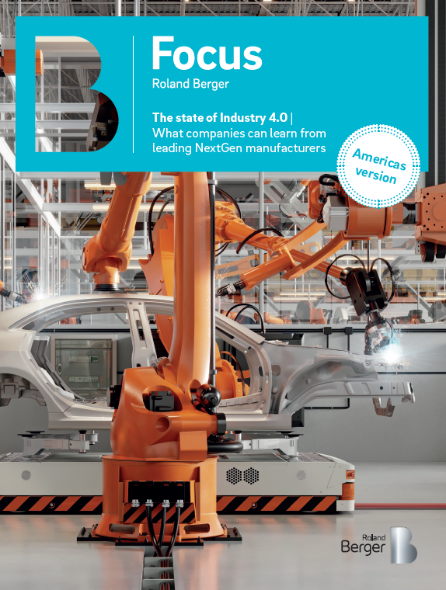Roland Berger has developed a wide range of future-oriented consulting services for manufacturers on the road to Next Generation Manufacturing.
The state of Industry 4.0
![{[downloads[language].preview]}](https://www.rolandberger.com/publications/publication_image/Cover_Page_Industry_4.0_download_preview.png)
What companies can learn from leading Americas NextGen manufacturers.


The term " Industry 4.0 " was coined more than ten years ago to describe the revolutionary efficiency gains that could be achieved by digitalizing manufacturing operations. While many manufacturers have taken initial steps to experiment with and implement new technologies, most have not yet realized Industry 4.0’s anticipated improvements. It has also become clear that various technological and organizational challenges make the digitalization of manufacturing more complex than initially expected.
In our new report, The State of Industry 4.0, Roland Berger examines how companies can learn from leading Americas NextGen manufacturers - and how companies can structure their own Industry 4.0 efforts in order to develop a clear strategy and vision that realizes the benefits of digital manufacturing technologies.

Roland Berger has helped a wide range of global and Americas-based manufacturers to structure their Industry 4.0 efforts and develop a clear strategy and vision to realize the benefits of digital manufacturing technologies. Based on numerous client engagements and interviews with leading market experts, we have identified manufacturing companies that have enjoyed more success and made significant advances over the past decade. These companies have multiple attributes in common.
First, they have a good understanding of their starting point and a holistic strategy towards Industry 4.0 that considers market realities. Second, they have a clear prioritization of digital manufacturing use cases, a dedicated cross-functional advanced manufacturing team, a clear IT/OT target landscape, and a strong focus on employee capability building. This helps leaders to focus investments on solutions that drive the highest value and pull funds out of projects that do not generate a certain ROI.
Less mature companies across manufacturing industries can learn from these best practices and develop their own vision and comprehensive strategy to accelerate their journey to "Industry 4.0".
"Given resource constraints and localization pressure, companies need to be pragmatic and focus on solutions with high impact. Leveraging best practices and a hub-and-spoke approach enables speed and efficiency to reach scalable solutions that quickly drive substantial value."
1. The current state of Industry 4.0
"Industry 4.0", or the digitalization of manufacturing, is a key building block in next-generation manufacturing. It enables a higher degree of automation on the road to fully autonomous production. Manufacturers have invested significant time and resources in building up the necessary capabilities and identifying, developing and rolling out use cases within their production plants. The automotive industry, in particular, has been pushing digitalization in manufacturing and is often considered to be leading (together with the semiconductor industry) when it comes to implementation. (For more on NextGen Manufacturing, read our report U.S. Manufacturers Disrupting Themselves: Increased Competitiveness and Resiliency through Next Generation Manufacturing ).
However, as more and more use cases are explored, it has become clear that the path to fully digitalized or autonomous production will be steeper than expected. Various technological and organizational challenges limit the speed at which manufacturing sites can be transformed.
2. Which "Industry 4.0" use cases offer the highest value?
There are a wide range of digital manufacturing use cases (many of which are industry- and manufacturing-process specific). We have structured these use cases into seven distinct archetypes. Most manufacturers have at least experimented with one use case from each archetype, but priority is given to the six use cases that provide the highest immediate value: in-process (real-time) parameter optimization; condition monitoring and predictive maintenance; automated vision-based inspection; process data-based inspection; autonomous material handling in intralogistics; and tracking of transport along the supply chain. These use cases account for a large part of companies' digital manufacturing investment.
3. How do Industry 4.0 leaders maximize benefits from the use cases?
The development and implementation of new digital manufacturing use cases is rarely straightforward. It requires solutions to various technical and organizational challenges. We used our discussions with Americas-based clients and market experts to better understand 1) the organizational setup and operating model, and 2) the IT/OT architecture that best-in-class players rely on to meet these challenges.
While the concrete set-ups vary from company to company, it is clear that three elements (hardware/use-cases [as described in chapter 2]; software/data & analytics; organization) need to be addressed simultaneously to realize the full benefits of Industry 4.0. Best-in-class companies share that vision and have a similar blueprint for the implementation of Industry 4.0 use cases.

4. What we can learn from Industry 4.0 leaders
The automotive and semiconductor industries are seen as front-runners in terms of digital manufacturing. While not all use-cases are transferable, their general approach is easily transferrable and works for manufacturers across industries. There are five key takeaways that companies should incorporate in their Industry 4.0 strategy.
Conclusion
Leading Industry 4.0 players follow a clear three-point strategy to drive the digitalization of manufacturing. First, they understand their starting point in the context of their industry environment and the possibilities of digital manufacturing solutions and have derived a clear vision that considers market realities. Second, a dedicated digital manufacturing unit with a clear operating model ensures that resources are optimally allocated and that the necessary capabilities are available. Companies can focus investments on backbone infrastructure to stay competitive, and initiatives that provide the highest ROI. Third, an IT/OT target landscape simplifies the rollout and subsequent maintenance of the implemented use cases.
Download the full report to learn more.

![{[downloads[language].preview]}](https://www.rolandberger.com/publications/publication_image/Cover_Page_Industry_4.0_download_preview.png)
What companies can learn from leading Americas NextGen manufacturers.